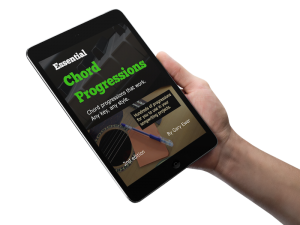If you’re a songwriter who favours the chords-first process, you’re used to doing a fair bit of improvising and experimenting, coming up with chord combinations that sound good.
In the improvising that you do, you’re possibly (or even probably) not aware of key. In other words, it’s quite possible to generate interesting chord progressions even if you don’t know the key of your song. Your ears will tell you if the progressions are working.
So that’s one answer: It doesn’t matter if you don’t know the key of your song; you can still come up with progressions that sound great.
But if you’re the kind of songwriter that likes to make things a little bit easier, knowing the key of your song can provide you with a shortcut to creating many usable chord progressions in a very short period of time. Here’s how that might work:
- Choose any key (let’s keep it simple and choose C major).
- Write out the notes of a C major scale: C-D-E-F-G-A-B
- Consider each of those notes to be the root of a chord, and build a 3-note chord — a triad — above each: C-E-G, D-F-A, E-G-B, etc.
- Identify each chord by name: C-E-G is a C chord; D-F-A is a Dm chord, E-G-B is an Em chord, etc.
- Apply a Roman numeral to each chord: C-E-G is a I-chord; D-F-A is a ii-chord; E-G-B is a iii-chord, etc. (Using Roman numerals makes transposing to your eventual best key a lot easier).
You’ve now got the seven chords that exist naturally in the key of C major:
- I: C-E-G (C)
- ii: D-F-A (Dm)
- iii: E-G-B (Em)
- IV: F-A-C (F)
- V: G-B-D (G)
- vi: A-C-E (Am)
- vii: B-D-F (Bdim)
You can can create dozens or more progressions by simply improvising on just those chords. And in fact, when you analyze most songs in the pop genres, you’ll notice that progressions will only occasionally include chords that aren’t in that short list.
So by starting the songwriting process by choosing a key, you make improvising chord progressions a much quicker process that gets you to the stage of writing melodies and lyrics much quicker.
Once you’ve got some simple progressions, you can then expand on what you’ve created to come up with progressions that are more creative and unpredictable. For example, you might take a simple progression like I-ii-V-I (C-Dm-G-C) and do any of the following:
- Add a lowered-VII-chord, or change the V-chord to a lowered-VII-chord: C-Dm-G-Bb-C, or C-Dm-Bb-C
- Add a secondary dominant chord. A secondary dominant takes a good deal of explanation, but to simplify it, simply take a chord that is normally minor, then switch it to major: C-D-G-C.
- Change a ii-chord to a lowered-III (major) chord: C-Eb-F-G.
- Change any chord to the version of that chord you’d find in a minor key. (If your chosen key is minor, change chords to the version you’d find in a major key): C-F-Fm-G-C
There are many more things you can do, of course, but the idea is this: By starting out with a simple progression that you know works, it makes it a lot easier to then make small changes to the progression. Those changes keep its strength but makes it sound more creative.
So this progression — C F Fm G Bb C — is one you might find by simply improvising, but you’re more likely to find it by establishing the key first, coming up with a basic 4-chord progression, and then applying one of the altered chords listed above.
In establishing the key first, you can come up with creative progressions in moments rather than spending all day trying to find them.
 Written by Gary Ewer. Follow Gary on Twitter.
Written by Gary Ewer. Follow Gary on Twitter.
 If all you need are tons of progressions to try out, you need “Essential Chord Progressions” and “More Essential Chord Progressions.” They’re both part of “The Essential Secrets of Songwriting 10-eBook Bundle”
If all you need are tons of progressions to try out, you need “Essential Chord Progressions” and “More Essential Chord Progressions.” They’re both part of “The Essential Secrets of Songwriting 10-eBook Bundle”










